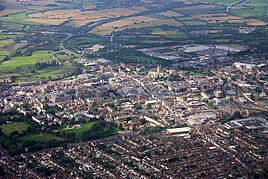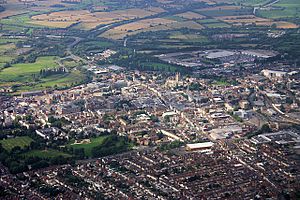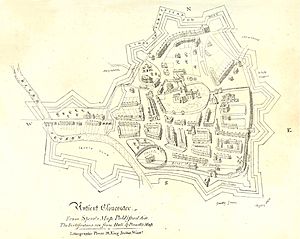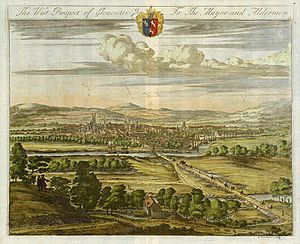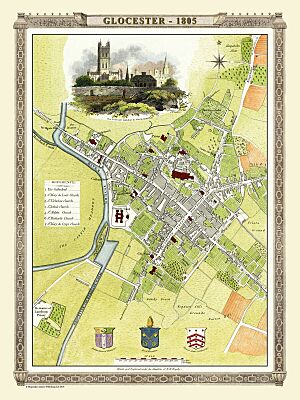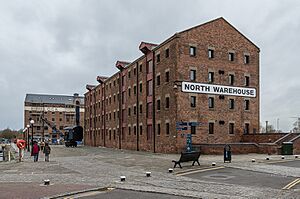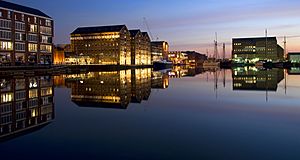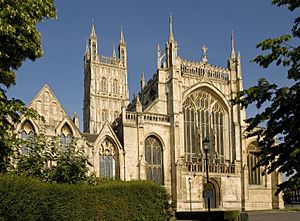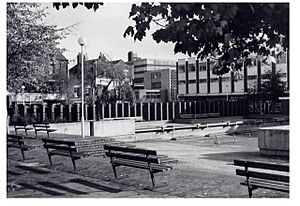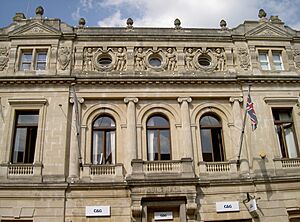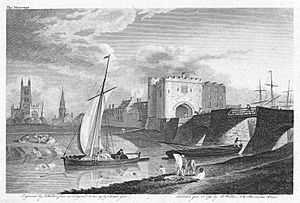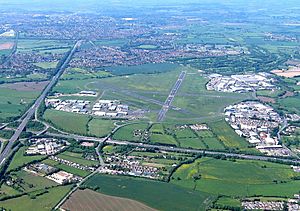Gloucester facts for kids
Quick facts for kids
Gloucester
|
||
|---|---|---|
|
City and non-metropolitan district
|
||
|
|
||
|
||
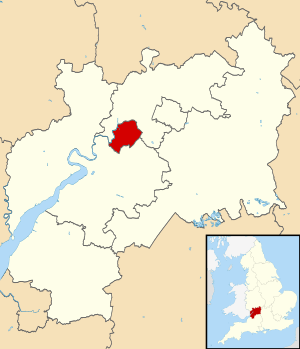
City of Gloucester shown within Gloucestershire
|
||
| Sovereign state | United Kingdom | |
| Country | England | |
| Region | South West England | |
| Non-metropolitan county | Gloucestershire | |
| Status | Non-metropolitan district, city | |
| Admin HQ | Gloucester | |
| Government | ||
| • Type | Non-metropolitan district council | |
| • Body | Gloucester City Council | |
| Area | ||
| • Total | 15.65 sq mi (40.54 km2) | |
| Area rank | 289th (of 326) | |
| Population
(2021 Census)
|
||
| • Total | 132,416 | |
| • Rank | 179th (of 326) | |
| • Density | 8,459.7/sq mi (3,266.3/km2) | |
| Ethnicity (2021) | ||
| • Ethnic groups |
List
|
|
| Religion (2021) | ||
| • Religion |
List
47.7% Christianity
39.7% no religion 7.9% other 4.7% Islam |
|
| Time zone | UTC0 (GMT) | |
| • Summer (DST) | UTC+1 (BST) | |
| Postcodes |
GL1-GL4
|
|
| Area code(s) | 01452 | |
| ONS code | 23UE (ONS) E07000081 (GSS) |
|
| OS grid reference | SO832186 | |
Gloucester (pronounced GLOSS-tər) is a historic city in the South West of England. It is the main city of Gloucestershire county. Gloucester is located on the River Severn. To the east are the Cotswolds hills, and to the west is the Forest of Dean.
The city is about 30 kilometers (19 miles) from Monmouth and 53 kilometers (33 miles) from Bristol. It is also about 27 kilometers (17 miles) east of the border with Wales. Gloucester has a population of around 132,000 people. It is an important port, connected to the Severn Estuary by the Gloucester and Sharpness Canal.
Gloucester was first built by the Romans. It became a very important Roman city and colony in AD 97. This happened under Emperor Nerva, and the city was called Colonia Glevum Nervensis.
In 1155, King Henry II gave Gloucester its first official document, called a charter. Later, in 1216, Henry III was crowned king in Gloucester Cathedral. He was only nine years old at the time. Gloucester was very important in the Middle Ages. It had many religious buildings, like St Peter's Abbey (which became Gloucester Cathedral).
The city was also the site of the siege of Gloucester in 1643. During this time, the city successfully defended itself against the Royalist army in the First English Civil War.
Today, a main attraction is Gloucester Cathedral. It is the burial place of King Edward II. Parts of the cathedral were even used in the Harry Potter movies. Other interesting places include the city museum and the old county jail. The Shire Hall, where the County Council works, is also here.
Gloucester's economy mainly involves service industries. It has strong financial, research, and distribution businesses. In the past, it was famous for its aerospace industry. In 1926, the Gloucestershire Aircraft Company changed its name to the Gloster Aircraft Company. This was because customers found "Gloucestershire" hard to spell. A sculpture in the city celebrates Gloucester's history with planes and the jet engine.
Contents
- What Does the Name Gloucester Mean?
- A Look Back at Gloucester's History
- How Gloucester is Governed
- Gloucester's Location and Surroundings
- Gloucester's Climate
- People and Cultures in Gloucester
- What to See and Do in Gloucester
- Gloucester's Culture and Traditions
- Churches in Gloucester
- Learning in Gloucester: Schools and University
- Getting Around Gloucester
- Businesses and Industries in Gloucester
- Sports and Fun in Gloucester
- Media and Entertainment
- Gloucester's Twin Cities
- Famous People from Gloucester
- See also
What Does the Name Gloucester Mean?
The name Gloucester comes from its Roman name, Glevum. After the Romans left, Anglo-Saxon people arrived around 410 AD. They changed the city's name to Caerloyw in modern Welsh. Caerloyw means 'fort, stronghold, or castle' and 'bright, shiny, or glowy'.
Later, a different part of the name, -cester, was used instead of the Welsh caer. So, the name Gloucester roughly means "bright fort." In the Middle Ages, it was also called Caer Glow or Gleucestre.
A Look Back at Gloucester's History
Roman Gloucester: How the City Began
The Romans built Glevum around AD 48. It was an important place because it was near a crossing point of the River Severn. A Roman fort was first built at Kingsholm. About 20 years later, a larger fort was built on higher ground. This new fort became the center of modern-day Gloucester.
A civilian town grew up around the fort. The Roman army's XX Valeria Victrix and later Legio II Augusta legions were based here. They prepared to invade Roman Wales from this location.
In 97 AD, Glevum became a Colonia under Emperor Nerva. This meant it was a special Roman city. It might have even been the capital of the Roman province called Britannia Prima.
Over the next 15 years, new buildings replaced the old army barracks. Stone temples and bath houses were built. The city also got piped water, drains, and sewers. A large central forum (public square) was created. Many beautiful homes with mosaic floors were built.
At its busiest, Glevum may have had as many as 10,000 people. The area around Glevum was very Romanized. Many Roman villas (country houses) were found there.
Around the late 200s or early 300s AD, the city's walls were made much stronger. They were rebuilt with large stone blocks. External stone towers were added. Two wide ditches were also dug in front of the new walls.
You can still see parts of the Roman city today. Many Roman items are in the Gloucester City Museum & Art Gallery. You can also see the remains of the Roman East Gate on Eastgate Street. The main streets like Northgate, Southgate, Eastgate, and Westgate still follow the old Roman roads.
Gloucester After the Romans Left
When the Roman army left Britain around 410 AD, local leaders likely took charge again. Gloucester became part of the Kingdom of Wessex after the Battle of Deorham in 577. Later, it was part of the smaller kingdom of the Hwicce. This kingdom then joined Mercia. Finally, Mercia joined Alfred the Great's Kingdom of Wessex around 877–883.
The city grew because it was the first place to cross the River Severn. In 681, St Peter's Abbey was founded. Before the Norman conquest of England, Gloucester was an important town. It had a castle that kings often used as a home.
In the early 900s, the remains of Saint Oswald were brought to a church here. This made Gloucester a popular place for pilgrims. The main street layout of the city dates back to this time.
Gloucester in the Middle Ages
After the Normans conquered England, William Rufus made Robert Fitzhamon the first lord of Gloucester. Fitzhamon also had a base at Cardiff Castle. Because of this, Gloucester's history was closely linked to Cardiff's for many years.
During a time of civil war called the Anarchy, Gloucester supported Empress Matilda. Her half-brother, Robert, 1st Earl of Gloucester, was Fitzhamon's grandson. He also supported Matilda.
When Matilda's son, Henry, became King Henry II, he gave Gloucester its first charter in 1155. This gave the people of Gloucester the same freedoms as those in London. A second charter gave them free travel on the River Severn. These rights were confirmed by King Richard I in 1194. King John gave even more rights in 1200.
In 1216, King Henry III was crowned in Gloucester Cathedral. He was only ten years old. Gloucester was very important in the Middle Ages. It had many religious houses:
- St Peter's Abbey (founded 679, later Gloucester Cathedral)
- St Oswald's Priory, Gloucester (founded 880s or 890s)
- Llanthony Secunda Priory (founded 1136)
- Franciscan Greyfriars (founded 1231)
- Dominican Blackfriars (founded 1239)
Some very old churches still stand, like St Mary de Lode Church, Gloucester and St Mary de Crypt Church, Gloucester.
There was also a Jewish community in Gloucester as early as 1158–1159. They lived near East Gate Street.
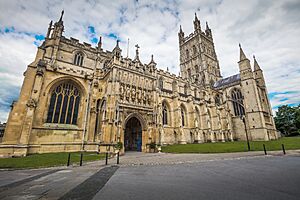
In the Middle Ages, Gloucester's main export was wool from the Cotswolds. Other exports included leather and iron tools. The city also had a large fishing industry.
In 1222, a big fire destroyed part of Gloucester.
A very important time for Gloucester began in 1378. King Richard II held Parliament in the city. Parliaments continued to be held there until 1406 under Henry IV of England. The Parliament Rooms at the Cathedral show how important this time was.
In 1483, King Richard III made Gloucester a county in itself.
From Early Modern Times to Today
Gloucester's special rights were confirmed by Queen Elizabeth I and King James I. Princess Mary visited Gloucester in 1525. Her father, Henry VIII, and Anne Boleyn visited in 1535.
In 1555, John Hooper, the Bishop of Gloucester, was executed by burning during the time of Queen Mary. In 1580, Queen Elizabeth I made Gloucester an official port.
In the 1500s and 1600s, two important schools were founded: the Crypt School in 1539 and Sir Thomas Rich's School in 1666. Both are still successful schools today.
During the English Civil War, Gloucester's defenses were strengthened. The siege of Gloucester began in 1643. The city's defenders, who supported Parliament, won the siege. The Royalist army's plans failed.
By the mid-1600s, only the gatehouse and main tower of Gloucester Castle remained. The tower was used as a prison until it was torn down in the late 1780s. A new prison was finished by 1791.
In the 1800s, the city grew with new buildings like Wellington Parade.
During the Second World War, two fuel storage depots were built in Gloucester. They were connected to pipelines and docks.
In July 2007, Gloucester was badly hit by a flood. Many homes were flooded. About 40,000 people lost power for a day. The whole city was without piped water for 17 days.
In 2009, Gloucester Day was brought back as a yearly celebration. This day remembers the lifting of the Siege of Gloucester in 1643.
Gloucester's Coat of Arms
Gloucester is special because it has two coats of arms. The first one has three V-shapes (chevrons) and ten circles (roundels). The chevrons come from the Clare family, who were important in Gloucester from the 1100s to the 1300s. The roundels come from the Bishop of Worcester. This coat of arms was officially given to the city in 1652. It also has a motto: Fides Invicta Triumphat, meaning "unconquered faith triumphs." This refers to the city's strong defense during the 1643 siege.
The second coat of arms was given in 1538. It shows roses, a boar's head, a sword, and horseshoes with nails. These symbols represent different parts of Gloucester's history, like its connection to iron work.
Even though the first coat of arms was from a different time, the city continued to use it. It was officially confirmed again in 1945 and 1974.
How Gloucester is Governed
Gloucester has two levels of local government. These are the Gloucester City Council and the Gloucestershire County Council. The area of Quedgeley within the city has its own town council. This makes it a third level of local government. The rest of the city does not have a separate parish council.
A Brief History of Gloucester's Government
Gloucester has been an important town since Saxon times. In 1155, Henry II gave it its first known charter. In 1483, Gloucester became a "county corporate." This meant it could manage its own affairs, separate from the rest of Gloucestershire. When the Diocese of Gloucester was created in 1541, the town was allowed to call itself a city.
In 1889, Gloucester became a "county borough." This meant it was large enough to provide its own county-level services. It was independent from Gloucestershire County Council.
The Gloucester Guildhall was built in 1892. It was the city's main office until 1986. Then, the council moved to North Warehouse at Gloucester Docks.
On April 1, 1974, the modern district of Gloucester was formed. The city lost some of its independence from the county council. In 1991, the parish of Quedgeley joined Gloucester. Quedgeley still has its own council. In 2017, Quedgeley Parish Council changed its name to Quedgeley Town Council.
Gloucester's Location and Surroundings
Gloucester is the main city of Gloucestershire. It is the 53rd largest settlement in the United Kingdom by population. In 2010, its population was 123,400. By 2021, the population of the Gloucester Urban Area was 169,061. This includes nearby areas like Brockworth and Churchdown.
The city is on the eastern side of the River Severn. The Cotswolds hills protect it to the east. The Forest of Dean and Malvern Hills are to the west and north. Gloucester is an inland port. It is connected to the Severn Estuary by the Gloucester and Sharpness Canal. This canal allows larger ships to reach the docks.
The old wharfs and warehouses at the docks were once run down. They were renovated in the 1980s and are now a public space. Some warehouses are now the Gloucester Waterways Museum. Others have been turned into homes, shops, and bars. The Soldiers of Gloucestershire Museum is also in the Custom House.
Gloucester has many different neighborhoods. Some of these match the city council's voting areas.
- Abbeydale
- Abbeymead
- Alney Island
- Barnwood
- Barton and Tredworth
- Coney Hill
- Coopers Edge
- Elmbridge
- Hempsted
- Hucclecote
- Kingsholm
- Linden
- Longford
- Longlevens
- Matson
- Podsmead
- Quedgeley (the only town within the city)
- St. Pauls
- Tuffley
- Westgate
- White City
- Wotton
The city itself does not have a green belt. However, it is bordered by a green belt in the nearby Tewkesbury district. This helps protect local green spaces. It also prevents the city from expanding too much towards Cheltenham and Innsworth. It also protects smaller villages nearby.
Gloucester's Climate
| Climate data for Gloucester/Cheltenham, (1991–2020 normals, extremes 1889–2001) | |||||||||||||
|---|---|---|---|---|---|---|---|---|---|---|---|---|---|
| Month | Jan | Feb | Mar | Apr | May | Jun | Jul | Aug | Sep | Oct | Nov | Dec | Year |
| Record high °C (°F) | 15.0 (59.0) |
18.0 (64.4) |
22.2 (72.0) |
26.7 (80.1) |
29.4 (84.9) |
34.6 (94.3) |
35.9 (96.6) |
37.1 (98.8) |
32.6 (90.7) |
26.7 (80.1) |
17.5 (63.5) |
16.2 (61.2) |
37.1 (98.8) |
| Mean daily maximum °C (°F) | 8.0 (46.4) |
8.6 (47.5) |
11.3 (52.3) |
14.6 (58.3) |
18.1 (64.6) |
20.8 (69.4) |
23.2 (73.8) |
22.2 (72.0) |
19.5 (67.1) |
15.1 (59.2) |
11.0 (51.8) |
8.5 (47.3) |
15.1 (59.2) |
| Daily mean °C (°F) | 5.2 (41.4) |
5.5 (41.9) |
7.5 (45.5) |
9.9 (49.8) |
13.2 (55.8) |
15.9 (60.6) |
18.3 (64.9) |
17.7 (63.9) |
15.0 (59.0) |
11.5 (52.7) |
8.0 (46.4) |
5.5 (41.9) |
11.1 (52.0) |
| Mean daily minimum °C (°F) | 2.3 (36.1) |
2.3 (36.1) |
3.6 (38.5) |
5.1 (41.2) |
8.2 (46.8) |
11.0 (51.8) |
13.4 (56.1) |
13.2 (55.8) |
10.5 (50.9) |
7.9 (46.2) |
4.9 (40.8) |
2.4 (36.3) |
7.1 (44.8) |
| Record low °C (°F) | −20.1 (−4.2) |
−13.9 (7.0) |
−11.7 (10.9) |
−6.1 (21.0) |
−3.3 (26.1) |
−0.3 (31.5) |
2.8 (37.0) |
1.6 (34.9) |
−0.8 (30.6) |
−6.1 (21.0) |
−8.6 (16.5) |
−13.1 (8.4) |
−20.1 (−4.2) |
| Average precipitation mm (inches) | 78.0 (3.07) |
65.8 (2.59) |
51.3 (2.02) |
69.2 (2.72) |
65.5 (2.58) |
71.3 (2.81) |
70.4 (2.77) |
72.3 (2.85) |
69.2 (2.72) |
80.5 (3.17) |
88.8 (3.50) |
84.8 (3.34) |
867.2 (34.14) |
| Average precipitation days (≥ 1.0 mm) | 12.8 | 11.0 | 10.7 | 11.4 | 11.0 | 10.5 | 10.7 | 11.2 | 10.2 | 12.6 | 13.7 | 13.4 | 139.0 |
| Mean monthly sunshine hours | 56.9 | 80.0 | 116.1 | 158.6 | 195.0 | 189.4 | 200.6 | 181.2 | 141.4 | 106.5 | 64.3 | 52.8 | 1,542.8 |
| Source 1: Met Office | |||||||||||||
| Source 2: Starlings Roost Weather | |||||||||||||
People and Cultures in Gloucester
Who Lives in Gloucester?
| Ethnic group | Year | |||||||||
|---|---|---|---|---|---|---|---|---|---|---|
| 1981 estimations | 1991 | 2001 | 2011 | 2021 | ||||||
| Number | % | Number | % | Number | % | Number | % | Number | % | |
| White: Total | 84,386 | 94.7% | 95,791 | 94.3% | 101,692 | 92.5% | 108,462 | 89.1% | 112,461 | 84.9% |
| White: British | – | – | – | – | 99,045 | 90.1% | 102,912 | 84.6% | 103,317 | 78.0% |
| White: Irish | – | – | – | – | 1,101 | 850 | 800 | 0.6% | ||
| White: Gypsy or Irish Traveller | – | – | – | – | – | – | 136 | 224 | 0.2% | |
| White: Roma | – | – | – | – | – | – | – | – | 296 | 0.2% |
| White: Other | – | – | – | – | 1,546 | 4,564 | 7,824 | 5.9% | ||
| Asian or Asian British: Total | – | – | 2,426 | 3,330 | 3% | 5,839 | 4.8% | 8,543 | 6.5% | |
| Asian or Asian British: Indian | – | – | 1,707 | 2,108 | 3,204 | 4,481 | 3.4% | |||
| Asian or Asian British: Pakistani | – | – | 177 | 301 | 639 | 1,160 | 0.9% | |||
| Asian or Asian British: Bangladeshi | – | – | 94 | 357 | 490 | 802 | 0.6% | |||
| Asian or Asian British: Chinese | – | – | 214 | 289 | 448 | 497 | 0.4% | |||
| Asian or Asian British: Other Asian | – | – | 234 | 275 | 1,058 | 1,603 | 1.2% | |||
| Black or Black British: Total | – | – | 2,786 | 2.7% | 2,523 | 2.3% | 3,486 | 2.9% | 4,826 | 3.6% |
| Black or Black British: Caribbean | – | – | 2,042 | 2,044 | 1,880 | 2,149 | 1.6% | |||
| Black or Black British: African | – | – | 127 | 241 | 1,100 | 1,912 | 1.4% | |||
| Black or Black British: Other Black | – | – | 617 | 238 | 506 | 765 | 0.6% | |||
| Mixed or British Mixed: Total | – | – | – | – | 2,103 | 1.9% | 3,565 | 2.9% | 5,014 | 3.8% |
| Mixed: White and Black Caribbean | – | – | – | – | 1,310 | 2,139 | 2,694 | 2.0% | ||
| Mixed: White and Black African | – | – | – | – | 121 | 316 | 569 | 0.4% | ||
| Mixed: White and Asian | – | – | – | – | 341 | 551 | 869 | 0.7% | ||
| Mixed: Other Mixed | – | – | – | – | 331 | 559 | 882 | 0.7% | ||
| Other: Total | – | – | 596 | 0.6% | 237 | 0.2% | 336 | 0.3% | 1,570 | 1.2% |
| Other: Arab | – | – | – | – | – | – | 119 | 332 | 0.3% | |
| Other: Any other ethnic group | – | – | 596 | 237 | 217 | 1,238 | 0.9% | |||
| Non-White: Total | 4,687 | 5.3% | 5,808 | 5.7% | 8,193 | 7.5% | 13,226 | 10.9% | 19,953 | 15.1% |
| Total | 89,073 | 100% | 101,599 | 100% | 109,885 | 100% | 121,688 | 100% | 132,414 | 100% |
Religious Beliefs in Gloucester
| Religion | 2001 | 2011 | 2021 | |||
|---|---|---|---|---|---|---|
| Number | % | Number | % | Number | % | |
| Holds religious beliefs | 85,280 | 77.6 | 81,488 | 67.0 | 72,001 | 54.3 |
| 81,687 | 74.3 | 75,881 | 62.4 | 63,145 | 47.7 | |
| 150 | 0.1 | 311 | 0.3 | 401 | 0.3 | |
| 488 | 0.4 | 728 | 0.6 | 1,283 | 1.0 | |
| 68 | 0.1 | 50 | <0.1 | 64 | <0.1 | |
| 2,477 | 2.3 | 3,885 | 3.2 | 6,200 | 4.7 | |
| 87 | 0.1 | 134 | 0.1 | 255 | 0.2 | |
| Other religion | 323 | 0.3 | 499 | 0.4 | 652 | 0.5 |
| No religion | 15,661 | 14.3 | 31,851 | 26.2 | 52,507 | 39.7 |
| Religion not stated | 8,944 | 8.1 | 8,349 | 6.9 | 7,908 | 6.0 |
| Total population | 109,885 | 100.0 | 121,688 | 100.0 | 132,416 | 100.0 |
What to See and Do in Gloucester
Gloucester Cathedral is in the north of the city, near the river. It started as an abbey in 681. It is where King Edward II is buried. The cathedral's cloisters (covered walkways) were used in the Harry Potter films. The crypt was also used in a Sherlock TV special. Outside the Abbey gate, Bishop John Hooper was martyred in 1555.
Many old medieval and Tudor period houses still stand in Gloucester. The New Inn on Northgate Street is a famous timbered building. It has large outside galleries and courtyards. A monk named John Twyning built it around 1450.
Kings Square is in the city center. It used to be a cattle market and bus station. It was opened in 1972 as part of a city redesign. Many of its original features have changed over time. For example, the concrete fountains are gone. A new bus station was built in 2018. In 2012, plans were made to update the square. A Roman house was found underneath during an archaeological dig.
An indoor market opened in Eastgate Street in 1968. The Eastgate Shopping Centre opened in 1973. The Kings Walk Shopping Centre was built between 1969 and 1972. Roman remains found under Eastgate Street in 1974 can be seen through a glass panel.
Gloucester Leisure Centre opened in 1974. It was updated and renamed "GL1" in 2002. Gloucester Central railway station was rebuilt in 1977. It now serves trains from the old Gloucester Eastgate station. One of the city's largest office buildings, Twyver House, is opposite the station. It opened in 1968. The main shopping streets became pedestrian-only in the late 1980s.
The 1966 Heights Plan for Gloucester aimed to protect views of Gloucester Cathedral. The tower of Gloucestershire Royal Hospital, finished in 1975, can be seen from far away.
Other interesting places include the museum and the old county jail. The Shire Hall is the main office for the County Council. A park in the south of the city has a spa. A special spring was found there in 1814. West of the canal are the remains of Llanthony Secunda Priory.
The city's Northgate and Southgate streets have public art mosaic panels. These show Gloucester's medieval trades. Artists Gary Drostle and Rob Turner made them in 1998 and 1999. Eastgate and Westgate streets also have mosaic panels.
Gloucester's Culture and Traditions
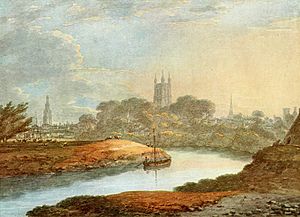
The Three Choirs Festival is one of the oldest music festivals in the British Isles. It started in the 1700s. It is held in Gloucester every third year. The other cities are Hereford and Worcester. Gloucester hosted the festival in 2019 and will again in 2023.
The main theater and cultural place in the city is the Guildhall. It hosts live music, dance, a cinema, and an art gallery. The GL1 Leisure Centre also hosts concerts.
The yearly Gloucester International Rhythm and Blues Festival happens in late July and early August. The Gloucester International Cajun and Zydeco Festival is the largest in the UK. It runs for a weekend every January. A Medieval Fayre is held in Westgate Street each summer.
Gloucester is also known for the Frightmare Halloween Festival. This is the largest Halloween festival in the South West.
The main museum is The Museum of Gloucester. There are also other important museums.
The Tailor of Gloucester House is dedicated to the author Beatrix Potter. It is near the cathedral.
Since 2013, Gloucester has celebrated Armed Forces Day. There is a service on College Green. Then, serving forces, veterans, and cadets parade through the city. They go to the docks for a family day with military displays.
Nature in Art is a gallery that shows art inspired by nature.
The city is mentioned in the nursery rhyme about Doctor Foster. He reportedly visited the city, got wet, and decided not to return.
Churches in Gloucester
Gloucester has many churches. It also used to have many chapels for different Christian groups. It is said that the old saying "as sure as God's in Gloucester" made Oliver Cromwell say the city had "more churches than godliness." Gloucester was home to the first Sunday school in England. Robert Raikes founded it in 1780.
Four churches of special interest are:
- St Mary de Lode – It has a Norman tower and a monument to Bishop John Hooper. It was built where an ancient Roman temple once stood. This temple became the first Christian church in Britain.
- St Mary de Crypt – This church was built in the 1100s. It has later additions, like its tower. The schoolroom where Crypt School started is also here.
- St Michael's Church – This church is believed to be connected to St Peter's ancient abbey.
- St Nicholas's Church – It was founded by the Normans. Many parts have been added since then.
Near St Mary de Crypt, you can find small remains of the Greyfriars and Blackfriars monasteries. Parts of the city wall are also there. Under the Golden Fleece and Saracen's Head inns, old vaulted cellars still exist. St Peter's Roman Catholic Church is also in the city.
During the building of the Boots store in 1974, Roman remains were found. You can see these through a glass case on the street. At the back of the Gloucester Furniture Exhibition Centre, you can see part of the city's South Gate.
Learning in Gloucester: Schools and University
Gloucester has several important schools. These include:
- The historic King's School, which was restarted by Henry VIII.
- The Crypt School, founded in 1539. It moved to Podsmead, about a mile from the city center.
- Sir Thomas Rich's School, which started in 1666.
- The High School for Girls (1883).
- Ribston Hall High School for Girls.
Other schools include Henley Bank High School, Beaufort Co-operative Academy, St Peter's High School (a Catholic school), Chosen Hill School, Severn Vale School, Gloucester Academy, Barnwood Park School, and Churchdown School Academy. There is also a Steiner Waldorf School.
The city is home to one of the three campuses of the University of Gloucestershire. This campus is at Oxstalls, just outside the city center. The university has also bought the old Debenhams store in the city center. A new campus is planned to open there in 2023. The university also has student housing in Gloucester. Its other campuses are in Cheltenham, about 11 kilometers (7 miles) away.
Getting Around Gloucester
Roads for Travel
The M5 motorway runs east of Gloucester. Junction 12 serves south Gloucester and Quedgeley. Junction 11a serves central Gloucester. Junction 11 serves north Gloucester. The A38 road goes north and south through Gloucester. It connects the city to Tewkesbury and Bristol. The A40 road goes west to east. It connects Gloucester to Cheltenham and the Forest of Dean. Other roads like the A46 and A417 link to other towns. Gloucester also has many cycle paths.
Before the Severn Bridge was built in 1966, Gloucester was the lowest point to cross the River Severn by road. This made it a very important link between South Wales and southern England. A bridge at Over, built by Thomas Telford in 1829, still stands. It is known for its flat arch. However, it is no longer used for traffic. A modern bridge was built next to it in 1974.
Train Services
Gloucester railway station has train services from several companies:
- Transport for Wales trains go between Maesteg, Cardiff Central, and Cheltenham Spa.
- CrossCountry trains go from Cardiff Central to Nottingham, passing through Birmingham New Street.
- Great Western Railway trains go to London Paddington, Bristol, and other towns.
Gloucester used to have a railway works called the Gloucester Railway Carriage and Wagon Company. It has now closed. A new station at Hunts Grove is being considered.
Buses and Coaches
Most local buses are run by Stagecoach West. They connect Gloucester to Cheltenham, Stroud, and Ross-on-Wye. National Express Coaches operate a route to London.
Canals for Boats
Gloucester is connected to the Severn Estuary by the Gloucester and Sharpness Canal. Small ships can use this canal. The city is also linked to the River Avon by the River Severn. Gloucester Docks mark the point where the river's tide stops.
Gloucester was once linked to Ledbury and Hereford by the Herefordshire and Gloucestershire Canal. This canal is now being restored.
Air Travel Options
Commercial airports with regular flights are Bristol, Birmingham, and Cardiff. These are about 64–97 kilometers (40–60 miles) away. Heathrow, a major international airport, is about 160 kilometers (100 miles) by road.
Gloucestershire Airport, located 13 kilometers (8 miles) east of the city, is used for private and special charter flights.
Businesses and Industries in Gloucester
Gloucester has a long history in the aerospace business. In 1926, the Gloucestershire Aircraft Company changed its name to the Gloster Aircraft Company. This was because international customers found "Gloucestershire" hard to spell. A sculpture in the city center celebrates Gloucester's aviation history. It also celebrates its part in developing the jet engine. Frank Whittle's first turbojet engine powered the Gloster E.28/39. This was the first British jet aircraft. It first flew at the company's airfield at Brockworth.
Today, Messier-Dowty's landing gear plant and GE Aviation Dowty Propellers plants are on the edge of the city.
The large insurance company Ecclesiastical Insurance is based in Gloucester. Lloyds Banking Group and TSB Bank also have offices in Barnwood.
Gloucester was home to Priday, Metford and Company Limited, a family milling business. It also had the hydraulic engineering firm Fielding & Platt.
Gloucester Business Park is on the outskirts of the city. It is home to several big companies.
Sports and Fun in Gloucester
- Gloucester was a host city for the Rugby World Cup in 1991 and 2015. It hosted four matches at the Kingsholm Stadium. Teams from Japan, Georgia, USA, Scotland, Tonga, and Argentina played there.
- Kingsholm Stadium is the home of Gloucester Rugby. This club was founded in 1873. It is one of Europe's top rugby union clubs. Gloucester-Hartpury, founded in 2014, also plays at Kingsholm. They play in the top women's rugby league.
- Meadow Park is the home of Gloucester City A.F.C.. This football club was founded in 1883. They play in the National League North. The club played outside the city from 2007 to 2020 because of floods.
- The Gloucester Cricket Festival is held at the King's School.
- Gloucester City Swimming Club competes in swimming championships.
- Gloucester City Hockey Club is based at Oxstalls Sports Park.
- The Gloucester Banshees American Football team plays at a national level.
- The University of Gloucestershire All Golds is the city's only professional Rugby league club.
- Gloucestershire Warriors are an amateur rugby league team.
- Public sports facilities are at the GL1 leisure center. It has swimming pools, a sports hall, and a gym.
Media and Entertainment
The Citizen is Gloucester's main newspaper. It shares content with the Gloucestershire Echo. Both are now weekly newspapers.
BBC Radio Gloucestershire has its studios in Gloucester. Heart West is based in Bristol. Gloucester FM is a community radio station.
Local radio is broadcast from Churchdown Hill.
For TV, Gloucester is covered by BBC West Midlands and BBC West on BBC One. It is also covered by ITV Central and ITV West Country on ITV.
Many TV shows and films have been filmed in Gloucester. The cathedral and docks are popular locations. These include three of the Harry Potter films, Doctor Who, and Alice in Wonderland: Through the Looking Glass.
Gloucester's Twin Cities
Gloucester is twinned with:
Gloucester was also twinned with Gouda in the Netherlands, but this twinning ended in 2015.
Famous People from Gloucester
Many notable people have lived in Gloucester, including:
- Æthelflæd (c.870–918), a powerful Anglo-Saxon leader.
- Yasmin Bannerman (b. 1972), an actress.
- Sir Alastair Cook (b. 1984), a famous cricketer.
- Alex Cuthbert (b. 1990), a rugby player for Wales.
- Dynamite MC (b. 1973), a musician.
- Marcel Garvey (b. 1983), a rugby player.
- Lynval Golding (b.1951), a musician.
- Ivor Gurney (1890–1937), a composer and poet.
- Button Gwinnett (1735 – 1777), who signed the United States Declaration of Independence.
- William Hayes (1708–1777), a composer.
- John Hooper (1495–1555), a bishop.
- Tom Kerridge (b. 1973), a chef and TV personality.
- Mary-Jess Leaverland (b. 1990), a singer.
- Jamie McDonald (b. 1986), an adventurer and author.
- Simon Pegg (b. 1970), a well-known actor and comedian.
- Robert Raikes (1735–1811), known for starting Sunday schools.
- Scott Redding (b. 1993), a motorcyclist.
- Tyler Roberts (b. 1999), a football player.
- John Stafford Smith (1750–1836), who composed the tune for the American national anthem.
- Nathan Sykes (b. 1993), a singer from the band the Wanted.
- Mike Teague (b. 1960), a former England rugby player.
- Charles Wheatstone (1802–1875), a scientist and inventor.
- George Whitefield (1714–1770), a leader in the Methodist movement.
- Chris Whitty (born 1966), the Chief Medical Officer for England.
See also
 In Spanish: Gloucester para niños
In Spanish: Gloucester para niños






